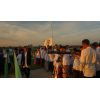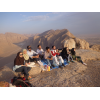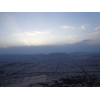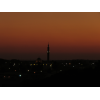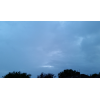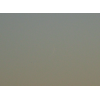Visibility of Dhul Qeadah Crescent 1437 AH
- When to Observe Dhul Qeadah Waxing (NEW) Crescent ?
- Dhul Qeadah Waxing (NEW) Crescent Observation Results
- The OFFICIAL First Day in Different Countries
- When to Observe Shawwal Waning (OLD) Crescent ?
- Shawwal Waning (OLD) Crescent Observation Results
When to Observe Dhul Qeadah Waxing (NEW) Crescent ?
The geocentric conjunction (Geocentric New Moon) will occur Inshalla on (Tuesday 02 August 2016) at 20:45 UT.
Sighting the new crescent on (Tuesday 02 August 2016) and (Wedensday 3 August 2016) is shown in the below graphs using the program Accurate Times by Mohammad Odeh according to Odeh criterion. Where:-
- It is impossible to see the crescent from the areas located under the red color. Because either the Moon on this day sets before the Sunset and/or the topocentric conjunction occurs after the Sunset.
- The crescent is expected to be seen by optical aid only from the areas located under the blue color.
- The crescent is expected to be seen by optical aid from the areas located under the magenta color. In these areas the crescent could be seen by naked eye if the atmospheric conditions are superb and the observer is experienced.
- The crescent is expected to be easily visible by naked eye from the areas located under the green color.
- The crescent cannot be seen from uncolored areas, even though the Moon sets in these locations after the Sunset and the topocentric conjunction occurs before the Sunset, but the Moon is not sufficiently illuminated in order to be seen as crescent even by optical aid.
- Kindly notice that the below graph shows the possibility of seeing the crescent from areas between 60 degrees north of Equator down to 60 degrees south of Equator.
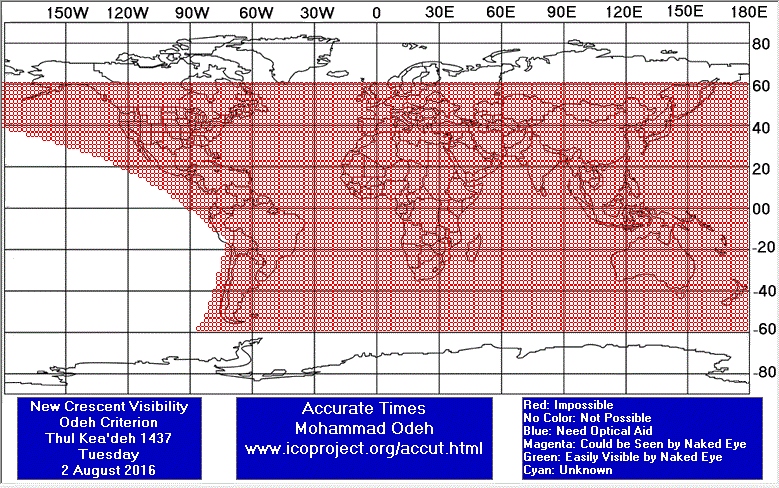

According to the Universal Hejric Calendar (UHC), which is based on the calculated crescent visibility, the start of this month in the Eastern Region will be on Thursday 04 August 2016 and in the Western Region will be on Thursday 04 August 2016. Kindly notice that the UHC is a pre-calculated calendar, which adopts a certain criterion to start the new Hejric month. Your country/organization might adopt different criterion to start the new Hejric month. So it is highly advised to read the UHC website before giving any judgment.
- Results of seeing the crescent, and the first day of the month in different countries will be added here Inshalla as we receive the reports from ICOP's members. If you wish to be a member in ICOP, or to know more about it, kindly click here.
Dhul Qeadah Waxing (NEW) Crescent Observation Results
Wed 03 August 2016
Algeria
Australia
Germany
Eng. Martin Elsaesser said: "The weather forecast for the evening is bad and the lag time to short anyway so i tried daytime imaging again. The sky had a lot of contrails and cirrus clouds. It was quite difficult to find the crescent under these conditions. Also the telescope mount had trouble with its power supply and some bugs tried to crawl into my notebook. Still, i could capture a series of images that clearly shows the slow drift of the crescent, even if the visible arc is quite short in any single image."
Indonesia
Mr. AR Sugeng Riyadi said: "The new crescent of Dzulqo'dah 1437 AH was not seen on Wednesday, 3 August 2016. The sky was totally hazy. I tried to observe with ustadz Ismail Al-Falaky (PSIF IAIN Malikussaleh) at the rooftop of OIF Universitas Muhammadiyah Sumatera Utara. Rukyat Hilal also held at Assalaam Observatory PPMI Assalaam Sukoharjo Surakarta Central Java by my students of CASA (Club Astronomi Santri Assalaam)."
Mr. AR Sugeng Riyadi said: "The daytime crescent of Dzulqo'dah 1437 AH was seen by ccd. This thin moon picture was recorded on Wednesday, 3 August 2016 by M. Yusuf and Team of Bosscha Observatory - ITB Bandung."
Iran
Mr. Hossein Janghorbani said: "In the name of God Dhul Qeadah Crescent Observation Report Astronomy and Geophysics Center of Shahreza – The Crescent Association of Shahreza Report by: Hossein Janghorbani (Najmosepehr-Sadrolmonajjemin) – Manager of Shahreza Crescent Association and Red Crescent’s Astronomy and Geophysics Center Date: Wedensday, 08/03/2016 Location: Damzad Mountaintop beside the historic Tower Senbandy in the East of Shahreza (latitude: 32 00 N, longitude: 51 52 E, elevation: 2325m from sea level, time zone: +4.5 GMT) Equipments: Two sets of 15*70 , One compass. Atmospheric condition: Clouds and Hazy in western horizon. Horizon obstacles: 0/5° Apparent sunset: 19:56 Actual sunset: 19:57 Results: Moon crescent was not seen. Damzad Mountain Range is located in East of Shahrza. Javad Amiri the manager of Geology and Geophysics department of G.A.C about the geological event of Damzad said: Damzad area is located in central domain of Sanandaj – Sirjan structural zone. The major rocks that outcrops in this area is gray limestone with Orbitolina and Ammonites fossils. The age of the rocks is Lower Cretaceous and distinctly Aptian (113 – 126 Million years ago). Observers: 1.Dr Fatemehsadat Emani 2.Maryam Rezaeezadeh 3.Mohammad Ali Emami 4.Sayed Farzad Alavi 5.Sayed Moslem Rezvani 6.Roya Ghrmezi 7.Zinat Ghermezi 8.Shakiba Moslehi 9. Hossein Janghorbani "
Mr. Hossein Janghorbani said: "In the name of God Dhul Qeadah Crescent Observation Report Astronomy and Geophysics Center of Shahreza – The Crescent Association of Shahreza Report by: Hossein Janghorbani (Najmosepehr-Sadrolmonajjemin) – Manager of Shahreza Crescent Association and Red Crescent’s Astronomy and Geophysics Center Date: Wedensday, 08/03/2016 Location: Damzad foothills in the East of Shahreza (latitude: 32 00 N, longitude: 51 52 E, elevation: 1825m from sea level, time zone: +4.5 GMT) Equipments: one sets of 8” Schmidt Newtonian Telescope , one set of 15*70 binoculars , two set of 20*90 binoculars , one set of 25*100 binoculars, one compass. Atmospheric condition: Clouds and Hazy in western horizon. Horizon obstacles: about 2° Apparent sunset: --:-- Results: Moon crescent was not seen. Observers : 1.Dr Ali Akbar Taki 2.Mohammad Ansaripoor 3.Mohammad Javad Nikeghbal 4.Reza Moslehi 5.Meysam Janghorban 6.Misagh Janghorban 7.Ali Janghorbani 8.Reza Janghorbani 9.Fatemeh Hadad 10.Masoomeh Hafar 11.Ziba Hafar 12.Nazanin Piroozmandan 13.Mahsa Khajeh 14.Narjes Zare 15.Fatemeh Tavakoli 16.Narges Shahnazari 17.Shahrzad Baghestani 18.Zahra Ali beygi 19.Toktam Aliabedi 20.Zahra Fallahi "
Libya
Eng. Mohammed Abdulkarim said: "لم تتم رؤية الهلال بالرغم من أن السماء كانت صافية."
Morocco
Oman
Mr. Turki Alamri said: "we started at 2:00 pm Lt me and alzaaq and Ammar the sky was so bad aod was 0.6 with clouds also we had a baffle issue we tried several technique but could not catch the crescent "
Saudi Arabia
Sri Lanka
Mr. Abdul Rahman Razeen said: "Aalaikum. Today 3-8-2016AD=29-10-1437AH is the sighting day for the month of Dhul-Qaedah. I was in Addalachenai to arrange a sighting group.This area is situated in eastern province of Srilanka.The co-ordinates of the Grand mosque of Addalachenai is lat=7deg 14' 56.5" N Long=81deg 51' 18.7"E. I arranged a sighting group at a place called "Mullaitivu Ashraff Nagar" which is very close to the grand mosque.I was with an Alim whose name is Moulavi Masood (Rashady).We were their 20 minutes before the Sunset.The horizon was cloudy. The parameters are(at Addalaichenai) Sun set:6.23pm. Moon set:6:48pm. Lag=25minutes The prediction of the astronomers= *According to Eng.Khalid Shawkath and Eng.Shawkath Odeh = It is visible to optical aid only, *According to Eng.Bernard Yallop and SAAO=It is not possible even for telescope. The crescent was not sighted in any parts of Srilanka. Hence it was decided to complete the proceeding month as 30 days and to start the month of Dhul-Qaedah on 5-8-2016 by the president C.G.M.H.C. M.Riyadh (Baari) along with A.C.J.U.and M.R.C.A. The sighting day for the month of Dhul-Hijjah falls on Friday 2-9-2016."
United Kingdom
Eng. Qamar Uddin said: "It was totally cloudy in York, so the sun was not seen let alone the moon!”"
United States
Dr. Javad Torabinejad said: "It was cloudy and rainy in our region. I checked the western horizon at 8:33 pm EDT (sunset: 8:26 pm). Due to the presence of clouds, no actual sighting was done."
Thu 04 August 2016
Algeria
Mr. Ahmad Reda Mami said: "كان وقت غروب القمر بالتوقيت المحلي على الساعة: 20h40 تقريبا و بالتالي كانت مدة مكث الهلال بعد غروب الشمس في الأفق حوالي ساعة، و كان الهلال ضعيفا."
Bangladesh
Hungary
Morocco
Oman
Mr. Turki Alamri said: "We arrived at jabal shams on aug 3 morning tried to capture the new crescent but could not due to so bat weather condition with aod 619 nm is 0.6 also some squipmant was not available like the baffle so i hd to fix it manually , next day aug 4 we started observation early morning me and Ammar and Alzaaq with bad sky aod was 0.35 , first sight was 4:00 am UT with 807 nm ir filter"
Saudi Arabia
Eng. Muflih Arisa Adnan said: "A very thin crescent could be easily seen by eye directly. It was very beautiful crescent during this summer. I captured the crescent using cell phone camera. My apologize, the picture from my cell phone is not so clear. However, we still can see the crescent as a small white line (as pointed by white arrow) above a palm tree. "
The OFFICIAL First Day in Different Countries
Thu 04 August 2016
1 . Algeria
2 . Indonesia
Fri 05 August 2016
1 . Bangladesh
2 . Morocco
3 . Sri Lanka
When to Observe Shawwal Waning (OLD) Crescent ?
The geocentric conjunction (Geocentric New Moon) will occur Inshalla on (Tuesday 02 August 2016) at 20:45 UT.
Sighting the OLD crescent on (Tuesday 02 August 2016) and (Monday 1 August 2016) is shown in the below graphs using the program Accurate Times by Mohammad Odeh according to Odeh criterion. Where:-
- It is impossible to see the OLD crescent from the areas located under the red color. Because either the Moon on this day rises after the Sunrise and/or the topocentric conjunction occurs before the Sunrise.
- The crescent is expected to be seen by optical aid only from the areas located under the blue color.
- The crescent is expected to be seen by optical aid from the areas located under the magenta color. In these areas the crescent could be seen by naked eye if the atmospheric conditions are superb and the observer is experienced.
- The crescent is expected to be easily visible by naked eye from the areas located under the green color.
- The crescent cannot be seen from uncolored areas, even though the Moon rises in these locations before the Sunrise and the topocentric conjunction occurs after the Sunrise, but the Moon is not sufficiently illuminated in order to be seen as crescent even by optical aid.
- Kindly notice that the below graph shows the possibility of seeing the crescent from areas between 60 degrees north of Equator down to 60 degrees south of Equator.


Shawwal Waning (OLD) Crescent Observation Results
Mon 01 August 2016
Germany
Eng. Martin Elsaesser said: "I wanted to observe the simple crescent before sunrise this morning but we had clouds. Around 0900 the clouds had cleared and i could quickly find the crescent with the imaging system and a small lens in reasonably blue skies. I tried to see it visually with small binoculars but did not succeed. It would probably have worked with a higher magnification and a precisely pointed optics. "
Indonesia
Mr. AR Sugeng Riyadi said: "The old crescent of Syawwal 1437 AH was seen on Monday, August 1st 2016 from my backyard at Bendo Ketitang Juwiring Klaten Central Java Indonesia."


